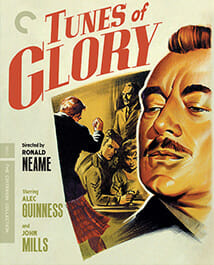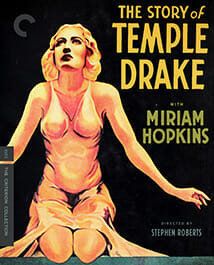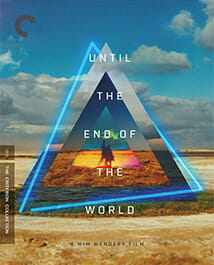Best of Criterion’s New Releases, December 2019

Each month, Paste brings you a look at the best new selections from the Criterion Collection. Much beloved by casual fans and cinephiles alike, Criterion has for over three decades presented special editions of important classic and contemporary films. You can explore the complete collection here.
In the meantime, because chances are you may be looking for something to give the discerning (raises pinkie) cinephile this month, find all of our Criterion picks here, check out some of our top titles this December, and, hey, maybe sign up for Criterion’s Criterion Channel to stream many of the titles we talk about here.
 Tunes of Glory
Tunes of Glory
Year: 1960
Director: Ronald Neame
Tunes of Glory is introduced as an anti-authority comedy about loveable misfits defying the death of fun, heralded by the arrival of the new tightwad-in-charge. Over an hour and 40 minutes, it morphs into an honest-to-goodness war movie, not the kind where men fight and die in glorious battle, but the kind that focuses on the effects that glorious battle has on the men who fight it. A Highland Regiment first bids farewell to Major Jock Sinclair (Alec Guiness) when he resigns his post as its commanding officer, and bristles immediately against his replacement, Lieutenant Colonel Basil Barrow (John Mills), an Oxford man seemingly born with a steel rod in his keister. Sinclair likes bawdy revelry. Barrow likes boring regulations. They’re boisterous oil and stuffy water. But rather than go the way of Police Academy or Super Troopers from there, the film slowly begins taking itself more seriously. Stray shots of absurdity—one soldier’s pajama pants slowly unrolling past his kilt as he dances Reels at the crack of dawn under Basil’s order—give way to macho posturing that clangs with PTSD. True to his forename, Sinclair is a brutish, cocky loudmouth, a rowdy good time on two legs until you tell him to turn down the volume. Barrow, by contrast, is something of a wet blanket, but there’s horror in his past and honor in his upbringing that drives him to shape the regiment into a force he deems respectable. Both men launch toward each other like ordnance, and Neame lets the audience feel the impact of their collision deep in the soul. His filmmaking lends Tunes of Glory the sense of order Barrow craves and the spirit Sinclair recklessly clings to. Neame is fastidious—he’ll have a ball when a ball is called for—but he’s focused on the idea that war is hell enough without it following the people who fight it home. Atmospheric final act beats evoking horror grammar impress on viewers the tragedy of honor sought and lost, veiled by performed masculinity and snuffed out with a single gunshot. Sinclair and Barrow have their reasons. Pity they’re better trained in dancing than they are in emoting. —Andy Crump
 The Story of Temple Drake
The Story of Temple Drake
Year: 1933
Director: Stephen Roberts
The Story of Temple Drake opens with a shot of Lady Justice’s shadow cast on a wall. It ends with Temple Drake (Miriam Hopkins) lying prone on a courtroom floor. She’s spent after retelling her tale of suffering to the judge, the jury, the audience and her boyfriend lawyer, Stephen (William Gargan), who pushes her to speak the truth and spare an innocent man the death penalty. Boiled down to a word, The Story of Temple Drake is complicated. It might even be problematic, though this has more to do with its functional titillation than anything else; this is seedy material about shocking subject matter, in which a spoiled rich girl falls into the clutches of a bootlegging gangster following a night of bad decisions. Even so, Stephen Roberts’ adaptation of the scandalous William Faulkner novel Sanctuary takes a tamer hand to Temple’s sexual assault, and to wrongs being righted. (For a rape-revenge movie, it ends on a surprisingly sunny note, though it must be stressed that “sunny” is a very relative term.) Most of all, Roberts has a sharper take on the role women play in an American court system presided over by men: They’re either ignored or kept silent until they’re forced to take the stand against their wishes. Lady Justice merely plays a background role in that first scene, where a judge gamely tries to undermine Stephen’s defense of a different client—which, for clarity’s sake, is not what a judge is supposed to do. Frankly, there isn’t much justice to find in The Story of Temple Drake except for the justice people make for themselves. —Andy Crump
 Until the End of the World
Until the End of the World
Year: 1991
Director: Wim Wenders
Wim Wenders insisted, reiterated plenty in Criterion’s presentation of the film’s 287-minute director’s cut, that Until the End of the World isn’t science-fiction. Except it is: In imagining 10 years later 30 years ago, the film’s prescience is both impressive and blurred by the slipstream of decades past, lost, as if in the same dream through which our protagonist Claire (Solveig Dommartin) wanders, to undefined borders of time. Which makes sense in the aftermath of the fall of the Berlin Wall, how such a self-described “ultimate road movie” could so embrace the vastness the world now seemed to represent. Claire, reeling in the wake of her boyfriend Eugene’s (Sam Neill) supposedly one-time affair with her best friend, embarks on an aimless sojourn throughout the known planet, itself on the verge of the new millennium, embroiled with a looming catastrophe care of none other than the United States military, threatening to shoot down an Indian satellite, causing untold devastation to the Earth. Adventures ensue; Claire has a chance meeting with two French bank robbers, Raymond (Eddy Mitchell) and Chico (Chick Ortega), and then with Trevor McPhee (William Hurt), the strangely alluring stranger who seems to have some weird eye problems and a few too many shady characters chasing after him. This chance meeting will come to envelop a vast array of lives, drawing them all to a hidden commune in the Australian outback and to two heartbreaking performances by Max von Sydow and Jeanne Moreau.
Until the End of the World foresees plenty, from GPS for the casual traveler to search engines and the Y2K scare, but most apocalyptic is the film’s odd speculation over the obsession with social media with which we currently contend. Obliquely, as Trevor McPhee’s decidedly sci-fi past emerges and Claire falls in love with him and the two seduce everyone they know and love to follow them to the edges of the globe, their lives are undone by a technology that allows them to remember, but not exactly—to remember everything they lost through the filter of their dreams, imperfectly but intimately. This is how we curate ourselves through social media, and then aspire to this curation, to crave these piece of ourselves we weren’t supposed to keep. Meanwhile, the aching beauty of the world revolves around them, Robby Müller’s cinematography capturing the Australian wild as breathlessly as Tokyo and San Francisco and Paris and Berlin. Self-serious and goofy as fuck, Until the End of the World playfully meanders through melodrama and mellifluously gorgeous naturalism alike—we know everything will be alright in the end, until we don’t. When Jeanne Moreau mutters that the Earth is in fact “not OK,” we know what she means. Or, at least, now we do—30 years later from the point at which Wim Wenders looked 10 years into his future and saw the universe unfold before him. —Dom Sinacola
GET PASTE RIGHT IN YOUR INBOX
The best music, movies, TV, books, comedy and more.